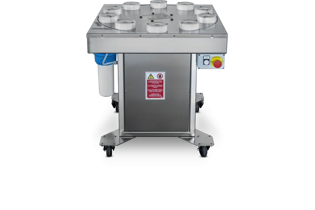
What are they?
The bottle rinsing machines are devices used in the packaging industry to clean and rinse bottles before filling. These machines remove dust, label residues, impurities, or any contaminants that may be present inside or outside the bottles. The rinsing operation is essential to ensure that the bottles are perfectly clean and safe for filling, preventing product contamination and ensuring packaging quality.
What do we offer?
1. Water Jet Rinsing Machines
Operation: These machines use water jets (sometimes mixed with detergents) that spray inside and outside the bottles to remove dust, pollen, or other impurities. The water is then drained, and the bottles are ready for filling.
Features: They can be equipped with adjustable nozzles to ensure uniform coverage of the bottle and effective cleaning.
Advantages: Effective in removing dust and impurities. Can handle bottles of different sizes.
Disadvantages: Do not provide deep disinfection unless combined with other process stages.
2. Compressed Air Rinsing Machines
Operation: In these machines, compressed air is used to blow inside and outside the bottle, removing dust and dirt residues without the use of water. The air pushes away particles and impurities, leaving the bottle ready for filling.
Features: Suitable for bottles that cannot be wetted or for fast productions where filling must occur immediately after rinsing.
Advantages: Does not use water, so it does not require a drainage system, and can be used in environments where humidity is undesirable.
Disadvantages: Not suitable for removing stubborn organic or inorganic contaminant residues.
3. Steam Rinsing Machines
Operation: These machines use hot steam to rinse and sterilize bottles. Steam is effective in disinfecting bottles and removing germs, bacteria, and other impurities.
Features: Mainly used in industries where deep sterilization is required, such as in the carbonated beverage, wine, or pharmaceutical sectors.
Advantages: Effectively disinfects bottles, reducing the risk of contamination.
Disadvantages: Requires a steam management system and proper maintenance. Not all bottles can be treated with steam, especially if they are very delicate.
4. Detergent Solution Rinsing Machines
Operation: These machines use a detergent solution to rinse bottles. The solution can be combined with water or used as a separate liquid to remove residues of oils, fats, or other difficult-to-remove substances.
Features: Particularly useful for bottles containing oils, juices, or other viscous liquids that might leave traces.
Advantages: Effectively removes even impurities that are difficult to eliminate with just water or compressed air.
Disadvantages: The use of detergents may require additional rinsing stages to remove any chemical residues.
5. Rotary Rinsing Machines
Operation: These machines are rotary and work on a series of bottles that are loaded onto a wheel or conveyor belt. Each bottle is subjected to jets of water, air, or steam as it moves along the production line.
Features: Can handle large volumes of bottles continuously and at high speed, and it is possible to integrate multiple rinsing stations for different treatments (e.g., water and air).
Advantages: High productivity and automation. Can handle different bottles simultaneously.
Disadvantages: More complex to manage and maintain compared to simpler machines.
6. UV Sterilization System Rinsing Machines
Operation: In these machines, bottles are exposed to ultraviolet (UV) light that eliminates bacteria, germs, and other microorganisms without the use of water or chemicals. The UV light is emitted in a chamber where the bottles are treated before filling.
Features: Ideal for industries that require sterilization without the use of chemical agents or heating, such as in the pharmaceutical sector or for certain types of beverages.
Advantages: UV sterilization is an effective and rapid method for reducing microorganisms without altering the product or using chemical solutions.
Disadvantages: Does not remove dust or other visible impurities and requires careful management of UV light.
7. Tunnel Rinsing Machines
Operation: Bottles are passed through a rinsing tunnel where they are treated with a combination of water, air, or steam jets. The tunnel is long and equipped with different stations where the bottles are immersed or subjected to specific treatments.
Features: Suitable for high productions, these machines allow continuous treatment of bottles.
Advantages: Can handle a large number of bottles automatically and continuously.
Disadvantages: Require careful management to avoid contamination between bottles and treatments.

FIMER


.jpeg)
.jpeg)


ENOPOGGIO







OFFICINE PESCE




